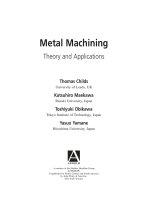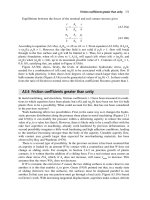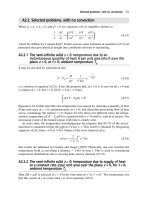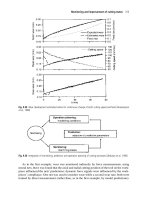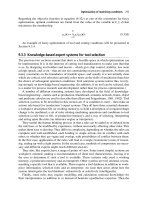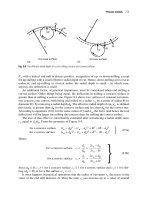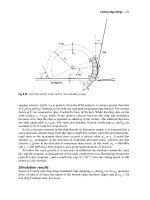Metal Machining - Theory and Applications Episode 2 Part 1 potx
Bạn đang xem bản rút gọn của tài liệu. Xem và tải ngay bản đầy đủ của tài liệu tại đây (217.03 KB, 20 trang )
p
ϕ
1 + sin
ϕ
cos y + sin k′
r
f
2
sin k′
r
cos y
A
uc
= fd + r
2
n
(
— + — – ————
)
+ r
n
f
(
—————— – 1
)
– ———————
4 2 cos
ϕ
cos
ϕ
2 cos
ϕ
(6.45a)
while for cases 2, 3 and 4
f 1
1
/
2
A
uc
=(d – r
n
)f + r
2
n
sin
–1
—— + — f
(
4r
2
n
– f
2
)
(6.45b)
2r
n
4
A
uf
, the projection onto the rake face, along the cutting direction, of the uncut chip
cross-section area is readily shown to be the division of A
uc
by the z′ component of e
Z
(x′)
in equation (6.27b):
A
uc
A
uf
= —————— (6.46)
cos l
s
cos a
n
6.4.8 Predictions from three-dimensional models
The relations from the previous sections may finally be used in the prediction of chip flow
direction and cutting force components. Colwell’s (1954) approach and the energy
approach initiated by Usui (Usui et al. 1978; Usui and Hirota, 1978; also Usui, 1990), will
particularly be developed and compared with experiments.
Non-orthogonal (three-dimensional) machining 193
Table 6.2 Values of the coefficients x′
1
, x′
2
, y′
3
,
θ
i
(i = 0 to 4) and t
1e,
θ
3–4
x′
1
x′
2
y′
3
r
n
(1 – sin
ψ
) d
————— ——— – f (sin
ψ
+ cos
ψ
tan
η
′
c
) r
n
(1 + sin
ϕ
)
cos
ψ
cos
ψ
θ
0
θ
1
r
n
_ df(d – r
n
)cos
η
′
c
+ r
n
sin (
ψ
+
η
′
c
)
sin
–1
{
———
}
–
ψη
′
c
+ sin
–1
{
— sin (
ψ
+
η
′
c
) – —————————————
}
r
n
r
n
r
n
cos
ψ
θ
2
θ
3
ff
η
′
c
+ sin
–1
{
— sin (
ψ
+
η
′
c
) – sin (
θ
0
–
η
′
c
)
}
η
′
c
+ sin
–1
{
— sin (
ψ
+
η
′
c
) – sin
η
′
c
}
r
n
r
n
θ
4
t
1e,
θ
3–4
r
n
cos(
η
′
c
–
θ
) + f cos(
η
′
c
+
ψ
)
π
f
1
/
2
— –
ψ
+ sin
–1
—— –
{
{
r
n
cos(
η
′
c
–
θ
) + f cos(
η
′
c
+
ψ
)
}
2
– f
2
– 2r
n
f cos(
ψ
+
θ
)
}
2 2r
n
Childs Part 2 28:3:2000 3:13 pm Page 193
Colwell’s geometrical model
The chip flow direction h′
c
in the x′ – y′ plane is assumed to be perpendicular to the
projected chord AD joining the extremities of the cutting edge engagement (Figure 6.14)
in the x′ – y′ plane. It is readily found by trigonometry, for the four cases shown in Figure
6.15. For Case 1 (Figure 6.15(a))
f cos
2
y cos
ϕ
tan h′
c
= ————————————————————— (6.47a)
(d – r
n
)cos
ϕ
+ r
n
(sin k′
r
+ cos y) – f cos
2
y sin
ϕ
while for Cases 2, 3 and 4 (in terms of q
4
given in Table 6.2)
r
n
(1 – cos q
4
)cos y
tan h′
c
= ————————————— (6.47b)
d + r
n
(sin y + sin q
4
cos y – 1)
Then, from equation (6.26b),
cos a
n
tan h′
c
+ sin l
s
sin a
n
tan h
c
= ———————————— (6.48)
cos l
s
This result alone is not sufficient for predicting machining forces: shear plane prediction
is required as well.
Usui’s energy model
As introduced in Section 6.4.1, it is assumed that f
e
, t
sh
, l and F
fric
/A
uf
are the same func-
tions of a
e
in three-dimensional machining as they are of a in orthogonal machining. From
Chapter 2 (Section 2.2), in orthogonal conditions
F
fric
t
sh
sin l cos a
—— = —————— ——— (6.49a)
A
uf
cos(f + l – a) sin f
Then, in three-dimensional conditions
t
sh
A
uf
sin l cos a
e
F
fric
= ——————— ——— (6.49b)
cos(f
e
+ l – a
e
) sin f
e
The friction work rate is F
fric
U
chip
and the primary shear work rate is t
sh
A
sh
U
primary
.
After applying equations (6.17b) and (6.17c), the total work rate is
cos a
e
sin l cos a
e
E
cutting
=
{
A
sh
————— + A
uf
————————————
}
t
sh
U
work
cos(f
e
– a
e
) cos(f
e
+ l – a
e
)cos(f
e
– a
e
)
(6.50)
For given tool angles, equations (6.26a) and (6.26b) are used to obtain a
e
and h′
c
in terms
of h
c
; A
sh
is then obtained from h′
c
, tool geometry and feed and depth of cut, from equation
(6.41), using Tables 6.1 and 6.2 as appropriate; A
uf
is determined from tool geometry,
feed and depth of cut by equations (6.46) and (6.45). Thus, equation (6.50), with f
e
, t
sh
and
194 Advances in mechanics
Childs Part 2 28:3:2000 3:13 pm Page 194
l as functions of a
e
, is converted to a function of h
c
, tool geometry, feed and depth of cut
and can be minimized with respect to h
c
.
Once the energy is minimized, the cutting force component F
c
is obtained from that
energy divided by the cutting speed; and F
fric
is found from equation (6.49b). The normal
force on the rake face, F
N
, is then found by manipulation of equation (6.30): from the rela-
tion between F
c
, F
fric
and F
N
F
c
– F
fric
sin a
e
F
N
= ——————— (6.51)
cos l
s
cos a
n
Equation (6.30) can also be used to obtain the feed and depth of cut force components.
(It is not correct to determine F
N
directly from F
fric
and the friction angle, as the friction
angle is defined, for the purposes of the energy minimization, in the cutting velocity–chip
velocity plane; and this does not contain the normal to the rake face.)
Comparison with experiments
The predictions of the various models have been compared by Usui and Hirota (1978), for
machining a medium (0.45%C) carbon steel with a P20 grade carbide tool. The orthogo-
nal cutting data for this were established by experiment as (with angles in rad and t
sh
in
MPa)
f = exp(0.581a – 1.139)
t
sh
= 517.4 – 19.89a
}
(6.52)
l = exp(0.848a – 0.416)
Figure 6.18 compares the measured and predicted dependencies of chip flow angle on
cutting edge inclination and tool nose radius. The energy method gives closer agreement
Non-orthogonal (three-dimensional) machining 195
Fig. 6.18 The dependence of
η
c
on (a)
λ
s
and (b)
r
n
, for machining a carbon steel (after Usui and Hirota, 1978)
(a)
Childs Part 2 28:3:2000 3:13 pm Page 195
with experiment than Stabler’s or Colwell’s prediction or a third prediction due to
Hashimoto and Kuise (1966). Figure 6.19, for the same conditions, shows that the energy
method also predicts the force components well.
The good results with the energy method come despite its approximations, that f
e
is the
same on every cutting velocity–chip velocity plane and that f
e
, t
sh
, l and F
fric
/A
uf
depend
196 Advances in mechanics
Fig. 6.19 Predicted (energy method) and measured cutting force components in the same conditions as Figure 6.18
(a)
Fig. 6.18
continued
(b)
Childs Part 2 28:3:2000 3:13 pm Page 196
only on a
e
for a given tool geometry, cutting speed and feed. In reality, chips do curl and
twist, so f
e
can vary from plane to plane (although, from Chapter 2, the extra deformation
from this is small compared with the main primary shear). In addition, around the tool nose
radius, the uncut chip thickness varies: it could be imagined that f
e
, t
sh
, l and F
fric
/A
uf
should be allowed to vary with t
1e
as well as with a
e
. Whether there are conditions in which
this extra refinement is necessary is unknown.
In the example just considered, the orthogonal cutting data were obtained by experi-
ment. The main interest today is that such data can be obtained by simulation, by the finite
element methods that are the subject of the following chapters.
References
Arsecularatne, J. A., Mathew, P. and Oxley, P. L. B. (1995) Prediction of chip flow direction and
cutting forces in oblique machining with nose radius tools. Proc. I. Mech. E. Lond. 209Pt.B,
305–315.
Childs, T. H. C. (1980) Elastic effects in metal cutting chip formation. Int. J. Mech. Sci. 22, 457–466.
Colwell, L. V. (1954) Predicting the angle of chip flow for single-point cutting tools. Trans. ASME
76, 199–204.
Dewhurst, P. (1978) On the non-uniqueness of the machining process. Proc. Roy. Soc. Lond. A360,
587–610.
Dewhurst, P. (1979) The effect of chip breaker constraints on the mechanics of the machining
process. Annals CIRP 28 Part 1, 1–5.
Hashimoto, F. and Kuise. H. (1966) The mechanism of three-dimensional cutting operations. J.
Japan Soc. Prec. Eng. 32, 225–232.
Hastings, W. F., Mathew, P. and Oxley, P. L. B. (1980) A machining theory for predicting chip geom-
etry, cutting forces, etc, from work material properties and cutting conditions. Proc. Roy. Soc.
Lond. A371, 569–587.
References 197
Fig. 6.19
continued
(b)
Childs Part 2 28:3:2000 3:13 pm Page 197
Kudo, H. (1965) Some new slip-line solutions for two-dimensional steady-state machining. Int. J.
Mech. Sci. 7, 43–55.
Lee, E. H. and Shaffer, B. W. (1951) The theory of plasticity applied to a problem of machining.
Trans. ASME J. Appl. Mech. 18, 405–413.
Merchant, M. E. (1945) Mechanics of the metal cutting process. J. Appl. Phys. 16, 318–324.
Oxley, P. L. B. (1989) Mechanics of Machining. Chichester: Ellis Horwood.
Palmer, W. B. and Oxley, P. L. B. (1959) Mechanics of metal cutting. Proc. I. Mech. E. Lond. 173,
623–654.
Petryk, H. (1987) Slip-line field solutions for sliding contact. In Proc. Int. Conf. Tribology – Friction,
Lubrication and Wear Fifty years On, London, 1–3 July, pp. 987–994 (IMechE Conference
1987–5).
Roth, R. N. and Oxley, P. L. B. (1972) A slip-line field analysis for orthogonal machining based on
experimental flow fields. J. Mech. Eng. Sci. 14, 85–97.
Shaw, M. C., Cook, N. H. and Smith, P. A. (1952) The mechanics of three dimensional cutting oper-
ations. Trans. ASME 74, 1055–1064.
Shi, T. and Ramalingam, S. (1991) Slip-line solution for orthogonal cutting with a chip breaker and
flank wear. Int. J. Mech. Sci. 33, 689–704.
Stabler, G. V. (1951) The fundamental geometry of cutting tools. Proc. I. Mech. E. Lond. 165, 14–26.
Stevenson, M. G. and Oxley, P. L. B. (1969–70) An experimental investigation of the influence of
speed and scale on the strain-rates in a zone of intense plastic deformation. Proc. I. Mech. E.
Lond. 184, 561–576.
Stevenson, M. G. and Oxley, P. L. B. (1970–71) An experimental investigation of the influence of
strain-rate and temperature on the flow stress properties of a low carbon steel using a machining
test. Proc. I. Mech. E. Lond. 185, 741–754.
Trent, E. M. (1991) Metal Cutting, 3rd edn. Oxford: Butterworth Heinemann.
Usui, E., Kikuchi, K. and Hoshi K. (1964) The theory of plasticity applied to machining with cut-
away tools. Trans ASME, J. Eng. Ind B86, 95–104.
Usui, E., Hirota, A. and Masuko, M. (1978) Analytical prediction of three dimensional cutting
process (Part 1). Trans. ASME J. Eng. Ind. 100, 222–228.
Usui, E. and Hirota, A. (1978) Analytical prediction of three dimensional cutting process (Part 2).
Trans. ASME J. Eng. Ind. 100, 229–235.
Usui, E. (1990) Modern Machining Theory. Tokyo: Kyoritu-shuppan (in Japanese).
Zorev, N. N. (1966) Metal Cutting Mechanics. Oxford: Pergamon Press.
198 Advances in mechanics
Childs Part 2 28:3:2000 3:13 pm Page 198
7
Finite element methods
In the previous chapter, Sections 6.2 and 6.3 established some of the difficulties and issues
in analysing even steady-state and plane strain chip formation. The finite element method
is a natural tool for handling the non-linearities involved. Section 6.4 suggested how
orthogonal (plane strain) results could be extended to three-dimensional conditions. An
eventual goal, particularly for non-plane rake-faced tools, must be the direct analysis of
three-dimensional machining; and the finite element method would appear to be the best
candidate for this. Chip formation is a difficult process to analyse, even by the finite
element method. This chapter is mainly concerned with introducing the method and
reviewing the learning process – from the 1970s to the present – of how to use it. Its appli-
cations are the subject of Chapter 8.
There are, in fact, several finite element methods, not just one. There is a coupling of
thermal and mechanical analysis methods. In the mechanical domain, different approaches
have been tried and are still in use. The differences cover how material stress–strain rela-
tions are described (modelling elasticity as well as plasticity, or neglecting elastic compo-
nents of stress and strain); how flow variations are described (relative to fixed axes, or
convecting with material elements – the Eulerian and Lagrangian views of fluid and solid
mechanics); how the elements are constructed (uniform, or structured according to physi-
cal intuition, or allowed to remesh adaptively in response to the results of the calculations);
and how some factors more specific to metal machining (for example the separation of the
chip from the work) are dealt with. A general background to these (to raise awareness of
issues more than to support use in detail) is given in Section 7.1. Section 7.2 surveys devel-
opments of the finite element approach (applied to chip formation), from the 1970s to the
1990s. Section 7.3 gives some additional background information to prepare for the more
detailed material of Chapter 8. To obtain accurate answers from finite element methods (as
much as for any other tool) it is necessary to supply accurate information to these meth-
ods. Section 7.4 considers the plastic flow behaviour of materials at the high strains, strain
rates and temperatures that occur in machining, a topic introduced in Chapter 6.3.
7.1 Finite element background
Fundamental to all finite element analysis is the replacement of a continuum, in which
problem variables may be determined exactly, by an assembly of finite elements in which
Childs Part 2 28:3:2000 3:13 pm Page 199
the problem variables are only determined at a set number of points: the nodes of the
elements. Between the nodes, the values of the variables, or quantities derived from them,
are determined by interpolation.
A simple example may be given to demonstrate the method: calculating the stresses and
strains in a thin plate (thickness t
h
) loaded elastically in its plane by three forces F
1
, F
2
and
F
3
. The plate is divided into triangular elements – the most simple type possible. Some of
them are shown in Figure 7.1.
The nodes of the problem are the vertices of the elements. Each element, such as that
identified by ‘e’, is defined by the position of its three nodes, (x
i
,y
i
) for node i and simi-
larly for j and k. The external loadings cause x and y displacements of the nodes,
(u
x,i
,u
y,i
) at i and similarly at j and k. The adjacent elements transmit external forces to
the sides of the element, equivalent to forces (F
x,i
,F
y,i
), (F
x,j
,F
y,j
) and (F
x,k
,F
y,k
) at the
nodes.
Strain – displacement relations
Displacements within the element are, by linear interpolation
u
x
= a
1
+ a
2
x + a
3
y; u
y
= a
4
+ a
5
x + a
6
y (7.1)
From the definition of strain as the rate of change of displacement with position, and
choosing the coefficients a
1
to a
6
so that, at the nodes, equation (7.1) gives the nodal
displacements,
Ѩu
x
(y
j
– y
k
)u
x,i
+ (y
k
– y
i
)u
x,j
+ (y
i
– y
j
)u
x,k
e
xx
= —— = a
2
= ———————————————— (7.2)
Ѩx 2D
200 Finite element methods
Fig. 7.1 To illustrate the finite element method for a mechanics problem
Childs Part 2 28:3:2000 3:14 pm Page 200
where D is the area of the element; and similarly for the other strains e
yy
and g
xy
. Matrix
algebra allows a compact way of writing these results:
u
x,i
e
xx
1
y
j
– y
k
0 y
k
– y
i
0 y
i
– y
j
0
u
y,i
{
e
yy
}
=——
[
0 x
k
– x
j
0 x
i
– x
k
0 x
j
– x
i
]
{
u
x,j
}
(7.3a)
g
xy
2D
x
k
– x
j
y
j
– y
k
x
i
– x
k
y
k
– y
i
x
j
– x
i
y
i
– y
j
u
y,j
u
x,k
u
y,k
or, more compactly still
{e}
element
= [B]
element
{u}
element
(7.3b)
where [B]
element
, known as the B-matrix, has the contents of equation (7.3a).
Elastic stress – strain relations
In plane stress conditions, as exist in this thin plate example, Hooke’s Law is
s
xx
E
1 n 0 e
xx
{
s
yy
}
=——
[
n 10
]{
e
yy
}
;or {s} = [D]{e} (7.4)
s
xy
1 – n
2
0 0 1 – ng
xy
——
2
Combining equations (7.3b) and (7.4)
{s}
element
= [D][B]
element
{u}
element
(7.5)
Nodal force equations, their global assembly and solution
Finally, the stresses in the element can be related to the external nodal forces, either by
force equilibrium or by applying the principle of virtual work. Standard finite element
texts (see Appendix 1.5) show
{F}
element
= t
h
D
element
[B]
T
element
[D][B]
element
{u}
element
(7.6)
Equations (7.6) for every element are added together to create a global relation between
the forces and displacements of all the nodes:
{F}
global
= [K]{u}
global
or, more simply {F} = [K]{u} (7.7)
where [K], the global stiffness matrix, is the assembly of t
h
D
element
[B]
T
element
[D][B]
element
.
For the assembled elements, the resultant external force on every node is zero, except
for where, in this example, the forces F
1
, F
2
and F
3
are applied. The column vector {F} is
a known quantity: equations (7.7) are a set of linear equations for the unknown displace-
ments {u}. After solving these equations, the strains in the elements and then the stresses
can be found from equations (7.3) and (7.4).
These steps of a finite element mechanics calculation are for the circumstances of small
strain elasticity. Plasticity introduces some changes and large deformations require more
care in the detail.
Rigid–plastic or elastic–plastic modelling
In plastic flow conditions, such as occur in machining and forming processes, it is natural
to consider nodal velocities u˘ instead of displacements u as the unknowns. Strain rates in
Finite element background 201
Childs Part 2 28:3:2000 3:14 pm Page 201
an element are derived from rates of change of velocity with position, in the same way that
strains are derived from rates of change of displacement with position. Over some period
of time, the strain rates generate increased strains in an element. In a time dt strain incre-
ments are:
{de} = [B]{u˘}dt (7.8)
The strain increment components have both elastic and plastic parts. The plastic parts
are in proportion to the total stress components but the elastic parts are in proportion to the
stress increment components (as described in Appendix 1). If elastic parts of a flow are
ignored, plastic flow rules lead to relations between the total stresses and the strain incre-
ments. These lead, in turn, (Appendix 1.5 gives better detail) to finite element equations of
the form
{F} = [K]{u˘}dt (7.9a)
Ignoring the elastic strains is the rigid-plastic material approximation. Equation (7.9a) is
commonly solved directly for the velocity of a flow, by iteration on an initial guess.
If the elastic strain parts of a plastic flow are not ignored, the flow rules lead to rela-
tions between element stress increment and strain increment components. The finite
element equations become
{dF} = [K]{u˘}dt or {F
˘
} = [K]{u˘} (7.9b)
In order to predict the state of an element, it is necessary to integrate the solution of equa-
tion (7.9b) along an element’s loading path, from its initially unloaded to its current posi-
tion.
The above descriptions are highly simplified. Appendix 1.5 gives more detail, particu-
larly of the non-linearities of the finite element equations that enter through the rigid–plas-
tic or elastic–plastic [D] matrix within the [K] matrix. The main point to take forward is
that elastic–plastic analysis gives a more complete description of process stresses and
strains but, because it is necessary to follow the development of a flow from its transient
start to whatever is its final state, and because of its high degree of non-linearity, it is
computationally very intensive. Rigid–plastic finite element modelling requires less
computing power because it is not necessary to follow the path of a flow so closely, and
the equations are less non-linear; but it ignores elastic components of strain. Particularly
in machining, when thin regions of plastic distortion (the primary and secondary shear
zones) are sandwiched between elastic work, chip and tool, this is a disadvantage.
Nonetheless, both rigid–plastic and elastic–plastic finite element analysis are commonly
applied to machining problems.
Eulerian or Lagrangian flow representation
There is a choice, in dividing the region of a flow problem into elements, whether to fix
the elements in space and allow the material to flow through them (the Eulerian view), or
to fix the elements to the flowing material, so that they convect with the material (the
Lagrangian view). Figure 7.2 illustrates these options. In the Eulerian case, attention is
drawn to how velocities vary from element to element (for example elements 1 and 2) at
the same time. In the Lagrangian case, attention is focused on how the velocity of a partic-
ular element varies with time. Each view has its advantages and disadvantages.
The advantage of the Eulerian view is that the shapes of the elements do not change
202 Finite element methods
Childs Part 2 28:3:2000 3:14 pm Page 202
with time, so the coefficients of the [B] matrix, which depend on element shape (for exam-
ple equation (7.3), for a triangular element), need only be computed once. However, in a
problem such as machining, in which determining the location of the free surface of the
chip is part of the problem to be solved, it is not clear where the elements should be drawn.
It is necessary to develop the free surface boundaries of the element mesh by iteration. A
more general problem is how to describe the convection of material property changes, like
strain hardening, from element to element. (Eulerian analyses are more common in fluid
mechanics than in solid mechanics because fluid properties vary less with deformation
than do those of solids.) In steady flow problems, it is assumed that material properties
convect along the streamlines.
The Lagrangian view has no problem with convection of material properties. The state
of a material is fixed in an element. However, the element changes shape during a flow: the
[B] matrix requires continued updating. This leads to geometrical non-linearities in addition
to material non-linearities in the finite element equations. In extreme cases it may become
necessary to simplify a distorted element shape by remeshing (see the next section). There
is a further complication. An element most likely rotates as well as distorts as it passes
through a flow (as shown in Figure 7.2). After a while, its local x and y directions will differ
from those of other elements. However, a common set of axes is required for the transfor-
mation of individual element equations to a global assembly. Counter-rotating the local
element coordinate system, as well as updating the [B] matrix, is repeatedly required.
Structured or adaptive meshing – and other matters
It is common sense that a finer mesh is needed where problem variables (velocity, temper-
ature) vary strongly with position than where they do not. In metal machining, fine detail is
needed to model the primary and secondary shear zones. This poses no problem for
Eulerian meshes: a choice is made where to refine the mesh and by how much. However,
for computing efficiency with a Lagrangian mesh, there is a need to refine and then coarsen
how the material is divided into elements as it flows into and out of plastic shear zones.
The need to refine Lagrangian meshes is particularly accute near the cutting edge of a
tool, where the work material flow splits into flow under the cutting edge and flow into the
chip. A range of approaches to separation at the cutting edge has been developed, from
introducing an artificial crack in the work, to highly adaptive remeshing, to developing
special elements with singularities in them. These are not needed in Eulerian analyses.
Finite element background 203
Fig. 7.2 Eulerian and Lagrangian views of a plastic flow
Childs Part 2 28:3:2000 3:14 pm Page 203
In addition to the choice of finite element method based on computational criteria,
particular softwares for metal machining should be able to model the variation of flow
stress with strain, strain rate and temperature (Section 6.3) and the variation of rake face
friction conditions from high load to low load conditions (Chapter 2, Section 2.4)
Summary
The choice of finite element methods for machining problems involves rigid-plastic or
elastic–plastic material models; Eulerian or updated Lagrangian flow treatments; struc-
tured or adaptive meshes; chip/work separation criteria needed or not needed; and coupling
to thermal calculation models or not. Some of the achievements of these approaches, and
methods of overcoming computational problems, are chronicled in the next section. On
balance, the updated Lagrangian analyses’ advantage of easily tracking material property
changes outweighs the disadvantages of computational complexity. The simplicity of
Eulerian computations is not fully realized in the large free surface movement conditions
of a chip forming process.
7.2 Historical developments
The 1970s
The earliest finite element chip formation studies (Zienkiewicz, 1971; Kakino, 1971)
avoided all the problems of modelling large flows by simulating the loading of a tool against
a pre-formed chip (Figure 7.3). A small strain elastic–plastic analysis demonstrated the
development of plastic yielding along the primary shear plane as a tool was displaced against
the chip. This work has a number of limitations, making it of historical interest only. For
204 Finite element methods
Fig. 7.3 Shear zone development, loading a pre-formed chip (Zienkiewicz, 1971)
Childs Part 2 28:3:2000 3:14 pm Page 204
example, it neglects friction between the chip and tool, and strain rate and temperature mater-
ial flow stress variations are not considered either. More fundamentally, it assumes the shape
of the chip in the first place: the main purpose of chip forming analyses is to predict the shape.
The limitations of this initial work were removed by Shirakashi and Usui (1976). While
keeping the computational advantages of supposing the tool to move into a pre-formed
chip, they developed an iterative way of changing the shape of the pre-form until the gener-
ated plastic flow was consistent with the assumed shape. They also included realistic
chip/tool friction conditions (from split-tool experiments), a temperature as well as a
mechanical calculation, and material flow stress variations with strain, strain rate and
temperature, measured from high strain rate Hopkinson bar tests (see Section 7.4). Their
iterative convergence method (ICM) is shown in Figure 7.4.
The first step of the ICM is to assume a steady state chip shape (similar to Figure 7.3,
except for supposing there to be a small crack at the cutting edge to enable the chip to
Historical developments 205
Fig. 7.4 The iterative convergence method (ICM) – Shirakashi and Usui (1976)
Childs Part 2 28:3:2000 3:14 pm Page 205
separate from the work) and (for plane strain modelling) to create a three-node triangular mesh
following the streamlines of the flow. In the first iteration, the tool is moved against the chip:
the development of nodal velocities is followed with an updated Lagrangian elastic–plastic
analysis. When it is judged that the plastic flow is fully developed, the nodal velocity field is
used to calculate the element strain rates along the streamlines; strains are obtained by inte-
grating the strain rates with respect to time along the streamlines (as if material had reached
its current position by flowing along a streamline). Temperatures are calculated from the inter-
nal and friction work rates and the work and tool materials’ thermal properties (in the first
application of the ICM, temperature was calculated by a finite difference method, but later the
finite element method was used). Material flow stress is then set according to its strain, strain
rate and temperature, the tool and chip are unloaded and the cycle of moving the tool into the
chip repeated. This is continued until converged strain rates and temperatures are achieved. At
that stage, the flow field is used to modify the initially assumed streamlines to be closer to the
calculated flow. The complete cycle is then repeated, and repeated again until the assumed and
calculated flow fields agree. The displacement of the tool needed to establish the flow field is
sufficiently small that the need to reform the crack at the cutting edge does not arise. Within
limits, the crack size does not influence the predicted chip flow.
Figure 7.5 shows chip shape, equivalent plastic strain rate and temperature fields
206 Finite element methods
Fig. 7.5 (a) Strain rates and (b) temperatures predicted by the ICM method for dry machining
α
-brass, cutting speed
48 m/min, rake angle 30˚, feed 0.3 mm
Childs Part 2 28:3:2000 3:14 pm Page 206
calculated by Shirakashi and Usui for machining an a-brass. Chip shape agrees with
experiment, as does the temperature field (which was studied experimentally with infrared
microscopy).
The procedure of loading a tool against an already formed chip greatly reduces comput-
ing capacity requirements and, in the 1970s, made elastic–plastic analysis possible. However,
it does not follow the actual path by which a chip is formed and, as outlined in Section 7.1
and Appendix 1, the development of elastic–plastic flows is path dependent. The justification
of the method is that it gives good agreement with experiment. The ICM has been developed
further, in analyses of cutting fluid action (Usui et al., 1977), built-up-edge formation (Usui
et al., 1981) and more recently in studies of low alloy semi free-machining steels (Childs and
Maekawa, 1990). It is given further consideration in Section 7.3 and Chapter 8.
The 1980s
Rigid–plastic modelling does not require the actual loading path to be followed (also
discussed in Section 7.1 and Appendix 1). Steady state rigid–plastic modelling, within a
Eulerian framework, also adjusting an initially assumed flow field to bring it into agreement
with the computed field, was first applied to machining by Iwata et al. (1984), using soft-
ware developed from metal forming analyses. They included friction and work hardening
and also a consideration of whether the chip would fracture, but not heating (and obviously
not elastic effects). Experiments at low cutting speed (0.15 mm/min in a scanning electron
microscope) supported their predictions. It was not necessary with the Eulerian frame to
introduce a crack at the cutting edge, but it was necessary, to avoid computational difficul-
ties, to give the cutting edge a small radius (about one tenth of the feed).
The mid-1980s, with a growth in available computer power, saw the first non-steady
chip formation analyses, following the development of a chip from first contact of a cutting
edge with a workpiece, as in practical conditions (Figure 7.6(a)). Updated Lagrangian elas-
tic–plastic analysis was used, and the chip/work separation criterion at the cutting edge
Historical developments 207
Fig. 7.6 Non-steady state analysis: (a) initial model and (b) separation of nodes at the cutting edge
Childs Part 2 28:3:2000 3:14 pm Page 207
became an issue (Figure 7.6(b)): should the connection between elements be broken by a
limiting strain, limiting energy or limiting displacement condition? Figure 7.7 shows the
earliest example (Strenkowski and Carrol, 1985), which used a strain-based separation
criterion. At that time, neither a realistic friction model nor coupling of the elastic–plastic
to thermal analysis (and hence nor a realistic flow stress variation with cutting conditions)
was included.
At the same time as plastic flow finite element methods were being developed for metal
machining, linear fracture mechanics methods were being developed for the machining of
brittle ceramics (Ueda and Sugita, 1983).
The 1990s
The 1990s have seen the development of non-steady analysis, from transient to discontin-
uous chip formation, the first three-dimensional analyses and the introduction of adaptive
meshing techniques particularly to cope with flow around the cutting edge of a tool.
Figure 7.8 shows an updated Lagrangian elastic–plastic simulation of discontinuous
chip formation in b-brass at low cutting speed. To obtain this result a geometrical
208 Finite element methods
Fig. 7.7 An example of non-steady state analysis (Strenkowski and Carrol, 1985)
Fig. 7.8 Discontinuous chip formation in
β
-brass (Obikawa
et al.
1997): (1–6) element deformation and (7) equiva-
lent plastic strain distribution, at different cut distances
l
(7)
Childs Part 2 28:3:2000 3:14 pm Page 208
(displacement controlled) parting criterion at the cutting edge was combined with an
empirical crack nucleation and growth criterion, considered further in Section 7.3 and
Chapter 8. Other authors have taken different approaches to crack growth during chip
formation (Ueda et al. 1991).
Figures 7.9 and 7.10 are the earliest examples of elastic–plastic steady and non-steady
three-dimensional analyses. The steady state example is an extension of the ICM to three
Historical developments 209
Fig. 7.9 Three-dimensional steady state chip formation by the ICM (Maekawa and Maeda, 1993): (a) initial model and
(b) equivalent strain rate distribution
Childs Part 2 28:3:2000 3:14 pm Page 209
dimensions. The non-steady example employs a geometrical parting criterion at both the
primary and secondary cutting edges. In both these cases, temperature and strain rate
effects are ignored, to reduce the computing requirements. This restriction was soon
removed: three-dimensional elastic–plastic, thermally coupled, ICM simulation soon
became used for cutting tool design, also considered further in Chapter 8 (Maekawa et al.
1994).
In parallel with the extension of elastic–plastic methods to non-steady and three-dimen-
sional conditions, the rigid–plastic method (Iwata et al., 1984) was similarly being devel-
oped (Ueda and Manabe, 1993; Ueda et al., 1996), with a shift from Eulerian to
Lagrangian modelling. Figure 7.11 shows the simulation of spirally curled chip formation
during milling with a non-zero axial rake tool. A simple form of remeshing at the cutting
edge, instead of a geometrical crack, was introduced to accommodate the separation of the
chip from the work.
Adaptive mesh refinement in non-steady flows, whereby during an increment of flow (a
time step) the mesh is fixed to the work material in a Lagrangian manner – but between steps
the mesh connectivity and size is changed according to rules based on local severities of
deformation – offers the advantage over fixed Lagrangian approaches of concentrating the
mesh where it is needed most, in the primary shear zone, at the cutting edge and along the
rake face. Concentration at the cutting edge provides an alternative to introducing a crack for
following the separation of the chip from the work. Both rigid–plastic (Sekhon and Chenot,
210 Finite element methods
Fig. 7.10 Three-dimensional non-steady chip formation (Sasahara
et al.,
1994): (a) element deformations and (b)
equivalent plastic strain distribution
Childs Part 2 28:3:2000 3:14 pm Page 210
1993; Ceretti et al., 1996) and elastic–plastic (Marusich and Ortiz, 1995) adaptive remesh-
ing softwares have been developed and are being applied to chip formation simulation. They
seem more effective than arbitrary Lagrangian–Eulerian (ALE) methods in which the mesh
is neither fixed in space nor in the workpiece (for example Rakotomolala et al., 1993).
Summary
The 1970s to the 1990s has seen the development and testing of finite element techniques
for chip formation processes. Many of the researches have been more concerned with the
development of methods than their immediate application value: the limited availability of
Historical developments 211
Fig. 7.11 Three-dimensional non-steady chip formation by rigid plastic finite element method (Ueda
et al
., 1996): (a)
initial model and (b) spiral chips
Childs Part 2 28:3:2000 3:14 pm Page 211
reliable friction and high strain, strain rate and temperature material flow properties did not
hold back this work. The ICM approach is the exception: from the start it has been
concerned with supporting machining applications. Now that all methods are approaching
maturity, attention is shifting to the provision of appropriate friction and material flow
property data (see Section 7.4).
In the future there are likely to be three main avenues of finite element modelling of
chip formation: (1) the ICM method for steady state processes, because of its extremely
high computing efficiency; (2) Lagrangian adaptive mesh refinement methods for unsteady
processes, both elastic–plastic as the most complete treatment and rigid–plastic for its
fewer computing requirements if elastic effects are not needed; and (3) fixed mesh
Lagrangian methods (with chip separation criteria) to support educational studies of
unsteady processes in a time effective manner. Chapter 8 will concentrate on the first and
the last of these, but a future edition may well include more of the second.
7.3 The Iterative Convergence Method (ICM)
Sections 7.3.1 and 7.3.2 give more details of the ICM method (which was introduced in
the previous section), as background to the examples of its use presented in Chapter 8.
Section 7.3.3 introduces a treatment of unsteady processes (case (3) above).
7.3.1 Principles and implementation
As has already been described, the ICM method is an updated Lagrangian elastic–plastic
finite element analysis for predicting steady state chip flows. Such analyses normally must
follow the development of strain along a material’s load path and are computationally very
intensive. The ICM method replaces the real path by a shorter one: loading the tool onto
an already formed chip. It provides a way, by iteration, of finding the formed chip shape
that is consistent with the material’s flow properties and friction interaction with the tool.
A key point is that its finite elements are structured to follow the stream lines of the steady
state chip flow (as will be seen in Figure 7.13).
The flow chart of the ICM procedure as it was originally introduced, is shown in Figure
7.4. Figure 7.12 shows its developed form. An initial guess of the chip flow or stream lines
(usually of the simple straight shear plane type considered in Chapter 2) is made and the
tool is placed so that its rake face just touches the back surface of the chip. Calculation
proceeds by incrementally displacing the workpiece towards the tool so that a load devel-
ops between the chip and tool. At each increment, it is checked if the plastic flow is fully
developed (saturated): if it is not, a further increment is applied (loop I). Once the flow is
developed, the initial guess is systematically and automatically reformed to bring it into
closer agreement with the calculated flow. The strain rate in each element of the reformed
flow is calculated; and the strain distribution is obtained by integrating strain rate along the
streamlines. The element flow stress associated with the reformed flow is then estimated;
but this requires temperature as well as strain and strain rate to be known. A second loop
(loop II), a thermal finite element analysis, is entered to determine the temperature field.
Finally, it is checked whether the derived material flow stress, temperature and flow fields
have converged: if they have not, the whole iteration is repeated (loop III). The next para-
graphs give some details that are special to the calculations.
212 Finite element methods
Childs Part 2 28:3:2000 3:14 pm Page 212

